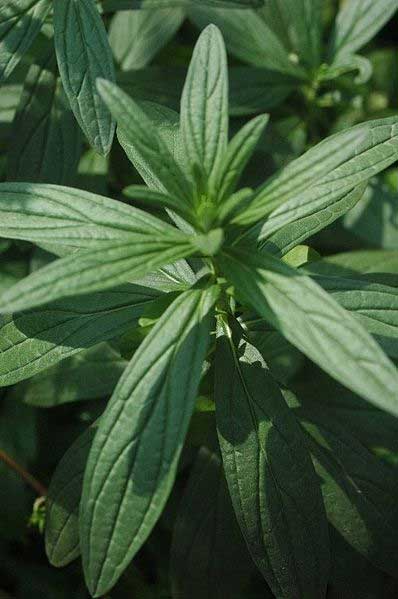
Lithospermum erythrorhizon (*)
Classification System: APG IV
Superregnum: Eukaryota
Regnum: Plantae
Cladus: Angiosperms
Cladus: Eudicots
Cladus: Core eudicots
Cladus: Asterids
Cladus: Lamiids
Ordo: Boraginales
Familia: Boraginaceae
Subfamilia: Boraginoideae
Tribus: Lithospermeae
Genus: Lithospermum
Species: Lithospermum erythrorhizon
Name
Lithospermum erythrorhizon Siebold & Zucc., Abh. Math.-Phys. Cl. Königl. Bayer. Akad. Wiss. 4(3): 149 (1846).
Synonyms
Lithospermum murasaki Siebold
Distribution
Native distribution areas:
Continental: Asia-Temperate
Regional: Eastern Asia
Amur, Chita, Japan, Korea, Manchuria, Primorye, Yakutskiya
Regional: China
China North-Central, China South-Central, China Southeast
References: Brummitt, R.K. 2001. TDWG – World Geographical Scheme for Recording Plant Distributions, 2nd Edition
References
Primary references
Siebold, P.F.v. & Zuccarini, J.G., 1846. Abhandlungen der Mathematisch-Physikalischen Klasse der Königlich Bayerischen Akademie der Wissenschaften 4(3):149. 1846
Links
Govaerts, R. et al. 2020. Lithospermum erythrorhizon in Kew Science Plants of the World online. The Board of Trustees of the Royal Botanic Gardens, Kew. Published online. Accessed: 2020 Oct 07. Reference page.
International Plant Names Index. 2020. Lithospermum erythrorhizon. Published online. Accessed: Oct 07 2020.
Tropicos.org 2020. Lithospermum erythrorhizon. Missouri Botanical Garden. Published online. Accessed: 07 Oct 2020.
Catalogue of Life: 2021 Annual Checklist
USDA, ARS, Germplasm Resources Information Network. Lithospermum erythrorhizon in the Germplasm Resources Information Network (GRIN), U.S. Department of Agriculture Agricultural Research Service. Accessed: 07-Oct-06.94
Vernacular names
English: lithospermum, purple gromwell, red-root gromwell
eesti: Puna-rusujuur
日本語: ムラサキ
한국어: 지치
svenska: Purpurstenfrö
中文: 紫草
Lithospermum erythrorhizon, commonly called purple gromwell, red gromwell, red-root gromwell and redroot lithospermum, is a plant species in the genus Lithospermum.[1] It is called zǐcǎo (紫草) in Chinese, jichi (지치) in Korean, and murasaki (ムラサキ; 紫) in Japanese.[1]
The dried root of Lithospermum erythrorhizon (lithospermum root or Lithospermi Radix) is a Chinese herbal medicine with various antiviral and biological activities, including inhibition of human immunodeficiency virus type 1 (HIV-1).[2][3]
The genome sequence of Lithospermum erythrorhizon is sequenced and has facilitated the discovery of a putative retrotransposition-derived duplication event that produced a 4-hydroxybenzoate geranyltransferase gene involved in alkannin biosynthesis.[4]
Biochemistry
The enzyme 4-hydroxybenzoate geranyltransferase utilizes geranyl diphosphate and 4-hydroxybenzoate to produce 3-geranyl-4-hydroxybenzoate and diphosphate. Biosynthetically, alkannin is produced in plants from the intermediates 4-hydroxybenzoic acid and geranyl pyrophosphate. This enzyme is involved in shikonin biosynthesis.
The enzyme geranylhydroquinone 3''-hydroxylase uses geranylhydroquinone, NADPH, H+ and O2 to produce 3-hydroxygeranylhydroquinone, NADP+ and H2O.
Culture
It has been cultivated in Japan since the Nara period for its root, which can be used for herbal medicine and to make dyes.
One Japanese word for the plant, murasaki (紫), inspired the pen name "Lady Murasaki" for the author of The Tale of Genji and is also the source of the general Japanese term for the color purple, murasaki iro (紫色).
The dyes made from its root also had other names, such as shikon (紫根), but all of them were difficult to work with because of their requirement for an alum-rich mordant and the resulting colors' extreme vulnerability to photobleaching. During the Heian Period, sumptuary laws restricted murasaki-dyed clothing to the Empress and her ladies in waiting.
See also
List of kampo herbs
References
"Lithospermum erythrorhizon". Germplasm Resources Information Network (GRIN). Agricultural Research Service (ARS), United States Department of Agriculture (USDA).
Chen, X., et al. (2003). Shikonin, a component of Chinese herbal medicine, inhibits chemokine receptor function and suppresses human immunodeficiency virus type 1. Antimicrobial Agents and Chemotherapy 47(9), 2810-16.
Gao, H., et al. (2011). Anti-adenovirus activities of shikonin, a component of Chinese herbal medicine in vitro. Biol Pharm Bull. 34(2) 197-202.
Auber, Robert P.; Suttiyut, Thiti; McCoy, Rachel M.; Ghaste, Manoj; Crook, Joseph W.; Pendleton, Amanda L.; Widhalm, Joshua R.; Wisecaver, Jennifer H. (2020-06-01). "Hybrid de novo genome assembly of red gromwell ( Lithospermum erythrorhizon ) reveals evolutionary insight into shikonin biosynthesis". Horticulture Research. 7 (1): 1–15. doi:10.1038/s41438-020-0301-9. ISSN 2052-7276. PMC 7261806.
Dalby, Liza (2001). Kimono: Fashioning Culture.University of Washington Press, pp. 236–237. ISBN 0-295-98155-5.
Wada Yoshiko; Mary Kellogg Rice, and Jane Barton (1983). Shibori: The Inventive Art of Japanese Shaped Resist Dyeing. Kodansha, pp. 278–279. ISBN 0-87011-559-6.
http://www.aisf.or.jp/~jaanus/deta/m/murasaki.htm Retrieved on 2007-04-20.
McGann, Kass (2003), Things to Wear — A History of Japanese Clothing: Japanese Dyestuffs, retrieved 2007-04-20
Retrieved from "http://en.wikipedia.org/"
All text is available under the terms of the GNU Free Documentation License

